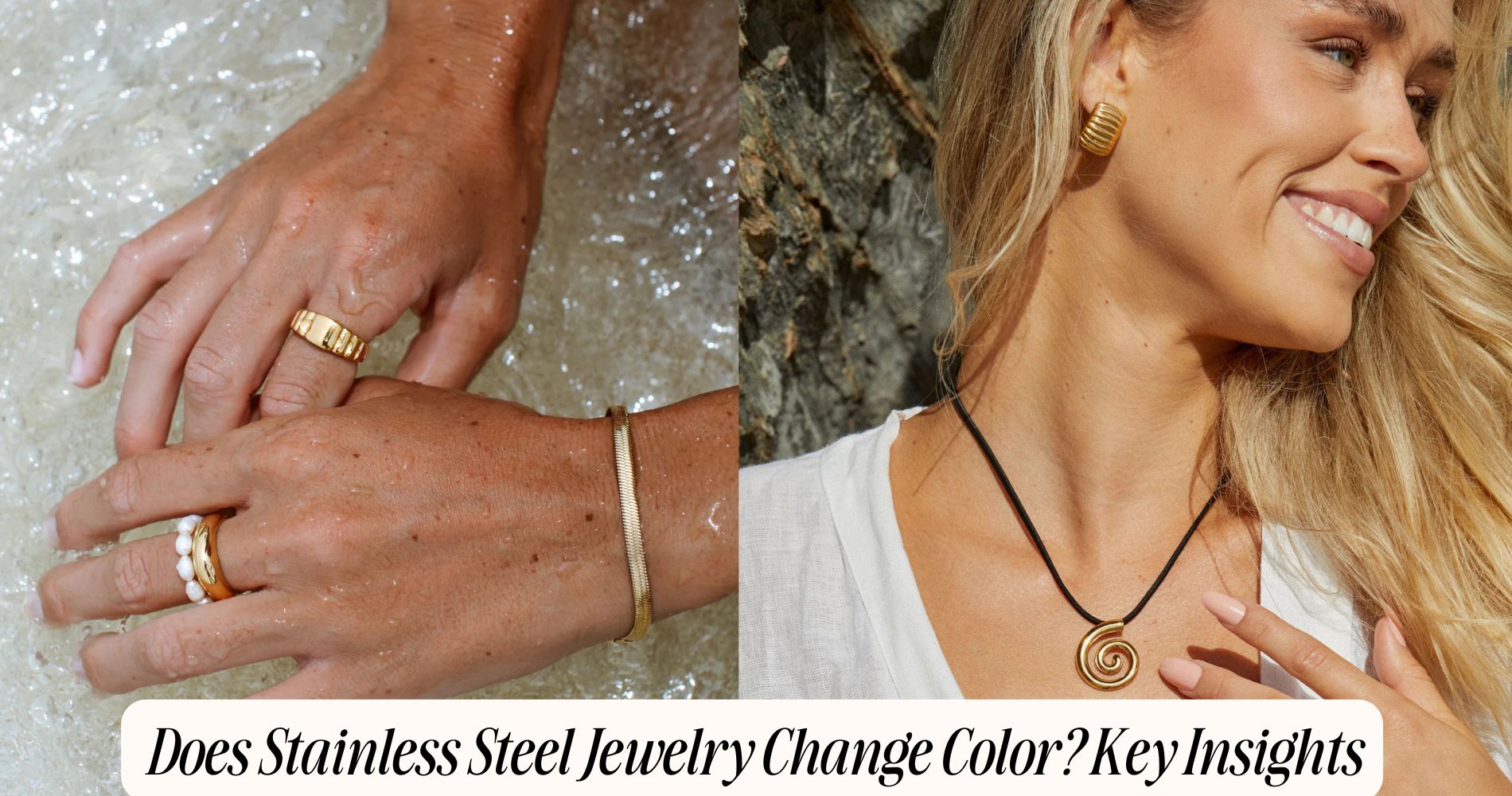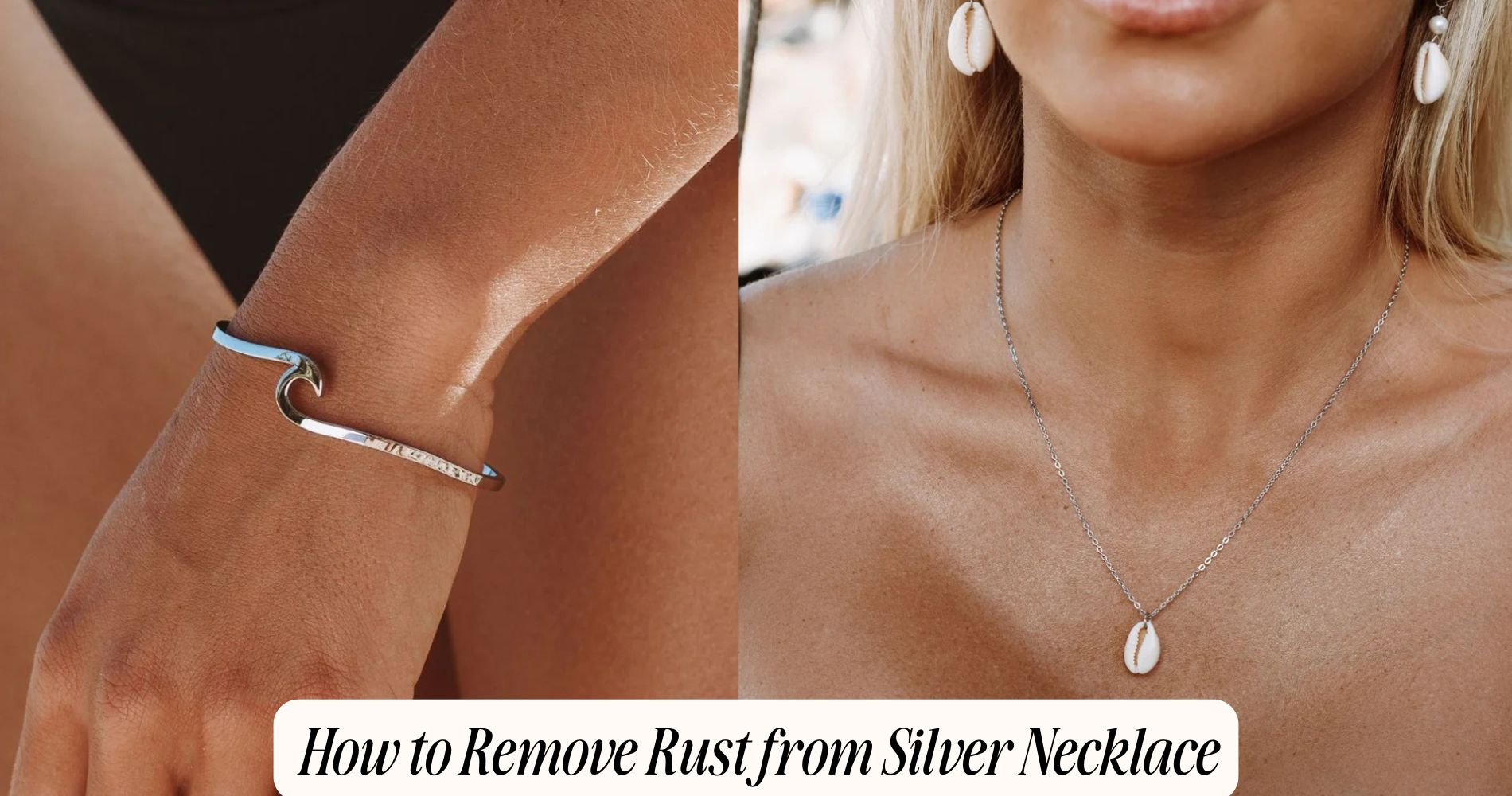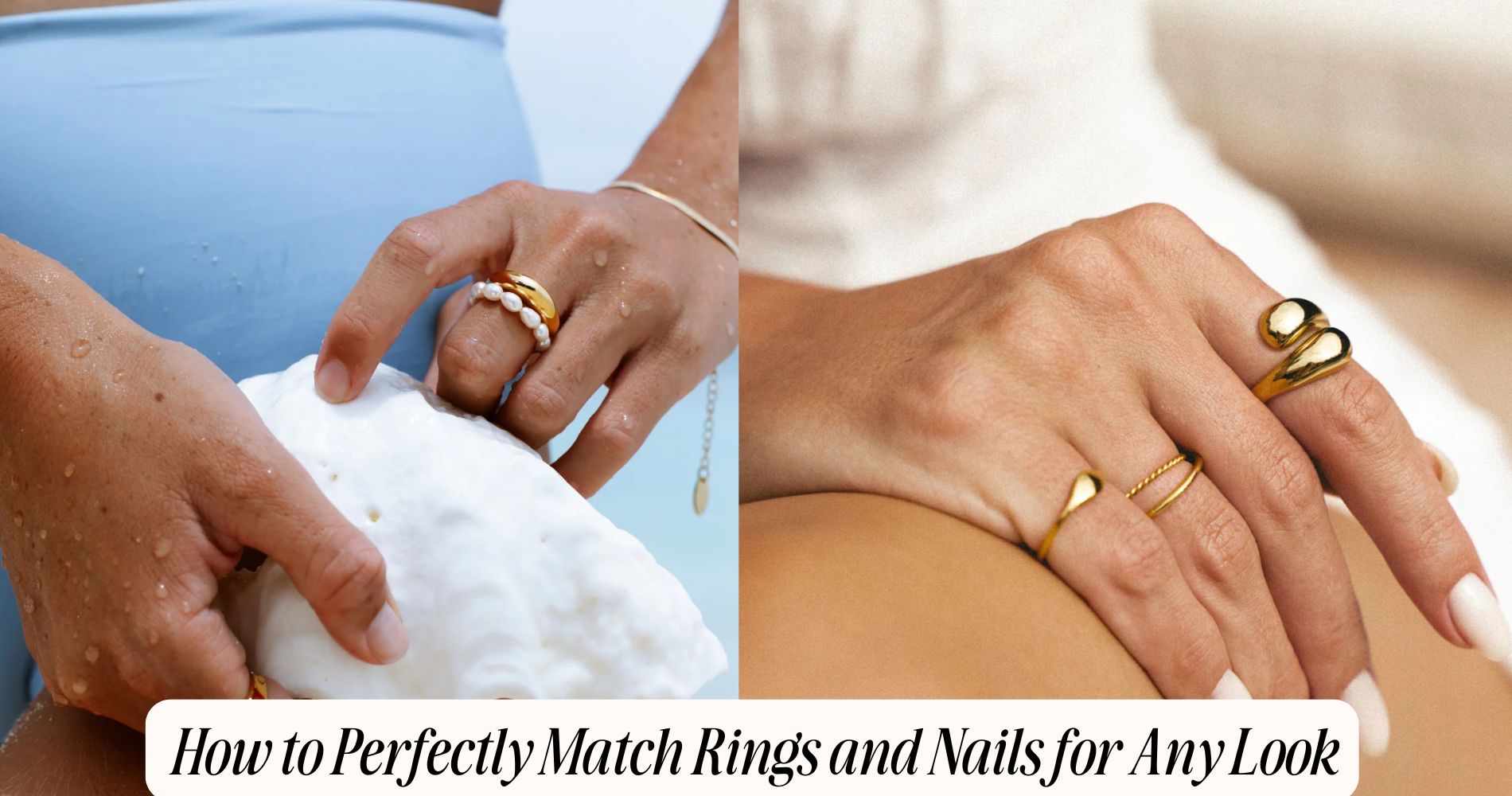
Does Stainless Steel Jewelry Change Color? Key Insights
Does stainless steel jewelry change color? Yes, it can over time. Factors such as the quality of the alloy, exposure to harsh chemicals, and environmental elements like sweat and humidity contribute to this change. Higher-grade stainless steel, such as 316 or 304, is more resistant to oxidation and tarnishing. However, neglecting proper care, especially when exposed to chlorinated water or personal care products, can accelerate discoloration. Regular cleaning and thoughtful storage are essential to maintaining its appearance. For durable and stylish options, explore our Stainless Steel Jewelry collection, and discover more tips on cleaning and preserving your jewelry.
Understanding Stainless Steel Alloys
Understanding stainless steel alloys starts with recognizing their composition and properties. You'll find that stainless steel isn't a single material but a variety of grades, each tailored for specific applications. The key to these grades lies in their alloy composition, which primarily includes iron, chromium, nickel, and sometimes molybdenum.
The chromium content, usually at least 10.5%, is essential as it forms a protective oxide layer that enhances corrosion resistance. Nickel enhances this property further, adding toughness and ductility.
Different stainless steel grades, such as 304 and 316, exhibit distinct characteristics due to the varying amounts of these elements. For instance, 316 stainless steel contains molybdenum, making it particularly resistant to pitting in chloride environments.
When choosing stainless steel for jewelry, understanding these grades and their alloy compositions helps you select pieces that best suit your lifestyle and aesthetic preferences.
You'll want to take into account factors like durability, resistance to tarnishing, and overall appearance. By grasping the nuances of stainless steel alloys, you'll make informed choices that guarantee the longevity and appearance of your jewelry.
Factors Affecting Color Change
Several factors can influence the color change of stainless steel jewelry, impacting its aesthetic appeal and longevity. One of the primary factors is the alloy composition itself. Different grades of stainless steel, particularly those with varying levels of chromium and nickel, exhibit different levels of color stability. Higher-quality alloys tend to have better oxidation resistance, which means they're less likely to tarnish or discolor over time.
Environmental conditions also play a significant role. Exposure to harsh chemicals, such as chlorinated water or household cleaners, can accelerate oxidation and lead to unwanted color changes. Humidity and salt from sweat or the ocean can further exacerbate this issue, especially if you're wearing your jewelry frequently.
Additionally, personal care products like perfumes or lotions can create a reaction with the metal, impacting its surface and altering its color.
Even the frequency of wear can influence how your jewelry maintains its appearance; regular cleaning can help preserve color stability and prolong the life of your pieces. Understanding these factors can help you take the necessary steps to keep your stainless steel jewelry looking vibrant and attractive for years to come.
Common Myths About Stainless Steel
Many people hold misconceptions about stainless steel jewelry that can lead to confusion when choosing pieces. One prevalent myth is that stainless steel is prone to rusting. In reality, high-quality stainless steel is corrosion-resistant, making it an ideal choice for jewelry that withstands daily wear.
Another common misconception is that stainless steel is the same as silver. While it may have a similar appearance, stainless steel is considerably more durable and less prone to tarnishing.
You might also hear that stainless steel can cause skin reactions. While some individuals may be sensitive to certain alloys, most stainless steel jewelry is hypoallergenic and safe for regular use.
Additionally, there's a belief that stainless steel jewelry is only available in a limited range of styles. This isn't true, as designers create a vast array of contemporary and classic designs.
Understanding these stainless steel myths helps dispel the jewelry misconceptions that can cloud your judgment. By recognizing the facts about stainless steel, you can confidently select pieces that suit your style and lifestyle without fear of misinformation.
How to Identify Quality Stainless Steel
To identify quality stainless steel, you should start by looking for specific markings, such as "316" or "304," which indicate higher-grade compositions.
Next, check if the material meets industry composition standards, ensuring it contains adequate levels of chromium and nickel for durability and resistance to corrosion.
Look for Markings
When evaluating the quality of stainless steel jewelry, one of the most effective methods is to look for specific markings that indicate the metal's grade and authenticity.
High-quality stainless steel typically features markings such as "316L" or "304," which are standards that denote corrosion resistance and durability. These markings serve as a reliable basis for marking identification, helping you distinguish genuine stainless steel from inferior alternatives.
Additionally, some reputable manufacturers may include their brand name or logo alongside the grade marking. This not only reinforces authenticity verification but also guarantees you're purchasing from a trusted source.
Check Composition Standards
Understanding the composition standards of stainless steel is essential for identifying quality jewelry. When you're evaluating a piece, look for a clear composition analysis that adheres to industry standards. Quality stainless steel typically consists of 10-20% chromium and a smaller percentage of nickel, which enhances durability and corrosion resistance.
To confirm you're investing in quality, ask for certification or documentation that validates the alloy's composition. Reputable manufacturers will often provide this information, allowing you to verify the material's integrity.
Another aspect to reflect on is the grade of stainless steel. Grades like 304 and 316 are commonly used in jewelry due to their excellent resistance to tarnishing and rusting.
If you find jewelry labeled as 430 stainless steel, be cautious—this grade lacks nickel and is less resistant to corrosion, making it less desirable for jewelry.
Finally, be aware of any discrepancies in the color or finish of the jewelry. If it looks too good to be true or is sold at an unusually low price, it may not meet the necessary composition standards.
Prioritize quality to avoid disappointment and confirm your jewelry stands the test of time.
Cleaning and Maintenance Tips
To keep your stainless steel jewelry looking its best, regular cleaning is essential.
You should use a mild soap and warm water solution, followed by thorough drying to prevent moisture buildup.
Additionally, proper storage practices, like using a soft pouch or a dedicated jewelry box, can help maintain its shine and prevent scratches.
Regular Cleaning Methods
Regular maintenance of your stainless steel jewelry is essential for preserving its shine and preventing color changes over time. To keep your pieces looking their best, establish a routine cleaning schedule based on your maintenance frequency. Depending on how often you wear your jewelry, a monthly cleaning is typically sufficient.
When it comes to cleaning solutions, mild soap and warm water work wonders. Simply mix a few drops of dish soap in a bowl of warm water, and soak your jewelry for a few minutes.
After soaking, use a soft-bristled toothbrush to gently scrub any hard-to-reach areas. Rinse thoroughly under cool water and pat dry with a soft cloth to avoid water spots.
For tougher stains or tarnishing, consider using a specialized stainless steel cleaner. Always follow the manufacturer's instructions to guarantee you're using the product safely and effectively.
Avoid harsh chemicals or abrasive materials, as these can damage the surface of your jewelry. By adhering to these regular cleaning methods, you'll maintain the brilliance of your stainless steel jewelry and keep it looking stunning for years to come.
Proper Storage Practices
Even with thorough cleaning, how you store your stainless steel jewelry can greatly impact its longevity and appearance. Proper storage practices are essential for preventing tarnishing and maintaining that shiny look you love.
Consider investing in jewelry boxes designed specifically for stainless steel. These boxes often contain compartments that protect individual pieces from scratching and tangling, which can lead to wear over time.
Moisture control is another important aspect of storage. Stainless steel is resistant to rust, but excessive moisture can still cause discoloration. To mitigate this risk, store your jewelry in a cool, dry place.
If you live in a humid environment, consider using silica gel packets in your jewelry box to absorb excess moisture.
Avoid leaving your stainless steel jewelry exposed to air for extended periods, as oxygen can lead to tarnishing. Whenever you're not wearing your pieces, place them in their designated compartments within the jewelry box, ensuring they're secure.
The Role of Coatings and Finishes
How do coatings and finishes influence the longevity and appearance of stainless steel jewelry? The application of various coatings and finishes can greatly enhance both the durability and aesthetic appeal of your pieces.
For instance, a PVD (Physical Vapor Deposition) coating provides a robust layer that not only resists scratches but also helps maintain the jewelry's original color. This coating durability is vital for ensuring that your jewelry withstands daily wear without losing its charm.
Different finish types, such as matte, polished, or brushed, can also alter the way light interacts with the metal, affecting its overall appearance. A polished finish may give your jewelry a shiny, reflective look, while a matte finish provides a more understated elegance. Each finish type has its unique characteristics that cater to your personal style.
However, it's important to reflect that not all coatings are created equal. Some may wear off over time, leading to potential color changes in the underlying stainless steel.
Understanding how these coatings and finishes work will help you make informed choices, ensuring your stainless steel jewelry remains stunning and resilient for years to come.
Environmental Influences on Jewelry
Environmental factors greatly impact the appearance and longevity of stainless steel jewelry. Understanding these influences can help you maintain the integrity of your pieces.
One of the primary concerns is oxidation effects. While stainless steel is highly resistant to rust, exposure to harsh conditions can lead to surface discoloration. For example, when stainless steel jewelry is frequently exposed to saltwater or chlorinated water, it may develop dull spots or a tarnished appearance over time.
Additionally, humidity impact plays a significant role. High humidity levels can create an environment conducive to corrosion, especially if the jewelry isn't cleaned regularly. When moisture accumulates on the surface, it can interact with any trapped contaminants, leading to potential discoloration or pitting.
To mitigate these issues, it's essential to store your stainless steel jewelry in a cool, dry place and to clean it regularly with a soft cloth.
Comparing Stainless Steel to Other Materials
Stainless steel jewelry stands out not only for its durability but also for its resistance to various environmental factors, especially when compared to other materials like silver, gold, or costume jewelry.
When you consider stainless steel vs. gold, you'll find that stainless steel is considerably more affordable while offering a similar aesthetic appeal. Gold can tarnish and scratch more easily, requiring regular maintenance to keep it looking pristine.
On the other hand, when comparing stainless steel vs. silver, the differences become even more pronounced. Silver is prone to tarnishing, especially when exposed to moisture, air, or certain chemicals. In contrast, stainless steel maintains its shine and luster over time, regardless of external conditions.
Both materials have their unique charm, but if you're looking for a long-lasting option that withstands the test of time, stainless steel is the clear winner.
It's hypoallergenic and won't corrode, making it ideal for everyday wear. To summarize, while gold and silver may have their allure, stainless steel offers practicality and resilience, ensuring that your jewelry remains as beautiful as the day you bought it.
Repairing Discoloration Issues
When you notice discoloration on your stainless steel jewelry, addressing the issue promptly can help restore its original shine. Discoloration often arises from exposure to chemicals, moisture, or even body oils.
To tackle this, start with basic cleaning methods. Use mild soap and warm water, gently scrubbing with a soft cloth or a toothbrush. This simple approach often suffices for discoloration removal.
If the discoloration persists, consider using a specialized jewelry cleaner designed for stainless steel. These products can penetrate deeper to lift stubborn stains and tarnish. Always follow the manufacturer's instructions to guarantee effective and safe application.
For more severe cases, you might need to consult a professional jeweler for jewelry restoration. They've access to advanced cleaning techniques and equipment that can rejuvenate your pieces without damaging them.
Additionally, professionals can assess whether the discoloration is due to a deeper issue, such as coating deterioration.
Tips for Long-lasting Jewelry
To guarantee your stainless steel jewelry stays stunning, it's essential to establish a regular cleaning routine.
Avoiding harsh chemicals will help maintain its luster, while proper storage solutions can prevent scratches and tarnishing.
Regular Cleaning Routine
Maintaining the beauty and integrity of your stainless steel jewelry requires a consistent cleaning routine. Establishing an appropriate cleaning frequency is key to preserving both its shine and durability. Ideally, you should clean your jewelry every few weeks, but if you wear it daily or expose it to sweat, lotions, or perfumes, consider a weekly cleaning schedule.
Your maintenance habits play a significant role in the longevity of your pieces. Start by using a soft cloth to wipe away any dirt or oils after each wear. This simple step can prevent buildup and keep your jewelry looking fresh.
When deeper cleaning is needed, use warm water mixed with mild soap and a soft brush to gently scrub away any residue. Rinse thoroughly and dry with a clean cloth.
Be mindful of how you store your jewelry, too. Keeping it in a dry, soft-lined box can minimize scratches and tarnishing.
Avoid Harsh Chemicals
Cleaning your stainless steel jewelry regularly is just one part of ensuring its longevity. To maintain its shine and integrity, you must also be mindful of the products you use during your jewelry care. Harsh chemicals can lead to adverse chemical reactions that may tarnish or discolor your pieces.
Common household cleaners, bleach, and abrasive scrubs can strip away the protective layer of your jewelry, making it more susceptible to stains and damage. Instead, opt for gentle cleaning solutions specifically designed for stainless steel. Mild soap and warm water can effectively remove dirt and grime without risking harm.
When cleaning, use a soft cloth or a non-abrasive sponge to avoid scratching the surface. After rinsing, dry your jewelry thoroughly to prevent moisture buildup, which can also contribute to discoloration over time.
Being vigilant about avoiding harsh chemicals isn't just about aesthetics—it's about preserving the quality of your investment. By prioritizing careful cleaning and using appropriate products, you can enjoy your stainless steel jewelry for years to come, without worrying about unwanted changes in color or finish.
Proper Storage Solutions
Properly storing your stainless steel jewelry can greatly reduce the risk of color change and damage over time. One effective method is to use a jewelry box specifically designed for storage. These boxes not only keep your pieces organized but also provide a protective environment that minimizes exposure to air and moisture, both of which can lead to tarnishing.
Consider the climate control of your storage area. Extreme temperatures and humidity can adversely affect your jewelry. Aim to store your stainless steel items in a cool, dry place. Avoid areas like bathrooms, where moisture can accumulate. Instead, opt for a bedroom drawer or a dedicated jewelry box in a climate-controlled environment.
Additionally, you may want to use anti-tarnish pouches or cloths within your jewelry box. These materials help absorb any moisture and keep the air around your jewelry dry.
Always store individual pieces separately to prevent scratching or tangling, which can compromise their appearance. By following these storage tips, you'll guarantee your stainless steel jewelry remains as stunning as the day you bought it, allowing you to enjoy it for years to come.
Frequently Asked Questions
Can Stainless Steel Jewelry Tarnish Like Silver?
Stainless steel jewelry doesn't tarnish like silver due to its durability. However, proper jewelry maintenance is still essential to prevent scratches or discoloration, ensuring it maintains its shine and resists any surface issues over time.
Is Stainless Steel Jewelry Hypoallergenic?
Yes, stainless steel jewelry is generally hypoallergenic for most people. However, some individuals may experience a stainless steel allergy, leading to skin reactions. Always test a small area before wearing new jewelry to verify compatibility.
How Does Temperature Affect Stainless Steel Jewelry?
Temperature effects on stainless steel jewelry can be significant. Heat exposure may cause structural changes, potentially weakening the metal. It's essential to avoid extreme temperatures to maintain the integrity and appearance of your jewelry.
Can I Wear Stainless Steel Jewelry While Swimming?
You can wear stainless steel jewelry while swimming, but for ideal swimming safety and jewelry maintenance, rinse it afterward to remove chlorine or saltwater, preventing potential tarnishing or damage over time. Enjoy your swim!
Conclusion
In summary, while stainless steel jewelry is known for its durability and resistance to tarnishing, it can still experience color changes due to various factors. By understanding the quality of the alloy and taking proper care, you can maintain its shine and integrity. Dispelling common myths and knowing how to clean and protect your pieces will guarantee they last longer. Ultimately, with attention and care, your stainless steel jewelry can remain a stunning addition to your collection for years to come.
























Leave a comment
This site is protected by hCaptcha and the hCaptcha Privacy Policy and Terms of Service apply.